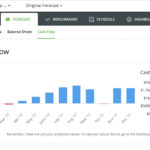Law firms face a unique challenge when it comes to managing finances: balancing the ebb and flow of client billing with the steady need for predictable cash flow. Whether your practice relies on billable hours, fixed fees, or a hybrid model, each approach affects how money moves through your business. Understanding cash flow for law firms and the differences in these models while setting up the right systems in QuickBooks Online can help you stay profitable and compliant while maintaining trust with your clients.
Let’s explore how both billing methods impact cash flow, the pros and cons of each, and practical ways to manage them effectively.
The Challenge of Cash Flow for Law Firms
Unlike many service businesses, law firms often experience uneven cash flow. Work may be completed long before payment is received, and trust accounting requirements can make the process even more complex. When billing and collections are delayed, partners may find themselves covering payroll or operating expenses out of reserves, despite strong billable activity on paper.
That’s why the billing model you choose has a major impact not only on revenue recognition, but also on cash predictability.
The two most common approaches; billable hours and fixed fees, affect how and when cash enters the firm, and how easily it can be tracked and forecasted in your accounting software.
The Traditional Approach: Billable Hours
The billable hour remains the cornerstone of most law practices. Attorneys record the time spent on each matter, assign an hourly rate, and invoice clients based on the total time incurred.
Pros
- Direct link between work and income: Every minute of work contributes to revenue, allowing attorneys to be compensated for all client-related activity.
- Transparency for clients: Detailed time entries show exactly how time was spent.
- Easier profitability tracking: Since revenue is tied to hours worked, it’s straightforward to compare time spent versus income earned.
Cons
- Unpredictable cash flow: Invoicing often happens after the work is completed, so cash inflow depends on when clients pay.
- Administrative burden: Tracking and reconciling billable hours requires diligent timekeeping and accurate reporting.
- Client resistance: Some clients may be wary of open-ended hourly billing, preferring fixed pricing for predictability.
Managing Billable Hours in QuickBooks Online
If your firm relies primarily on hourly billing, QuickBooks Online (QBO) can streamline both time tracking and invoicing. Each time entry can be linked to a specific client or matter, allowing you to easily generate billable time invoices.
Integration with legal practice management tools like Clio Manage, TimeSolv, or LeanLaw, makes it even easier. These platforms sync billable time directly to QBO, ensuring that every hour worked becomes an invoice item ready to send.
To improve cash flow, set clear billing cycles and use QBO’s automated reminders to follow up on overdue invoices. The “Projects” feature can also help you view profitability per client or case, comparing billable time against costs.
The Growing Trend: Fixed-Fee (Flat-Fee) Billing
More law firms are embracing fixed-fee arrangements, offering clients a set price for specific services. This approach provides certainty for clients and helps firms better forecast revenue.
Pros
- Predictable income: Flat fees create consistency in billing, which can stabilize cash flow over time.
- Simplified invoicing: Each project or matter can be billed once, without the need to tally hours.
- Client satisfaction: Clients appreciate knowing upfront what their legal costs will be.
Cons
- Risk of underpricing: If a matter takes longer than expected, profit margins can shrink quickly.
- Challenging to track profitability: Without detailed time data, it can be harder to assess how efficiently services are delivered.
- Potential compliance concerns: Flat-fee retainers may still need to be held in a trust account until earned, depending on jurisdictional rules.
Managing Fixed Fees in QuickBooks Online
For fixed-fee billing, QBO can handle project-based invoicing easily. Set up each matter as a project, assign the agreed-upon fee, and record payments as they’re received.
If your firm collects advance retainers, those funds should first be deposited into an IOLTA trust account in QuickBooks Online. Once the work is completed, move the funds to your operating account by recording a transfer or using a journal entry that reflects the income as earned.
Recurring services, like ongoing business counsel or subscription-style legal support, can be managed through recurring invoices in QBO. This helps automate the billing process while keeping income consistent month to month.
Comparing the Two Models: Which is Better for Cash Flow?
Each billing model impacts cash flow differently. The key is to understand your firm’s workload, client base, and tolerance for variability.
| Billing Model | Cash Flow Predictability | Profitability Tracking | Client Perception |
| Billable Hours | Variable. Depends on invoicing and payment timing | Straightforward. Hours linked to revenue | Transparent but potentially open-ended |
| Fixed Fees | More consistent. Especially for recurring services | Requires close monitoring to ensure margins | Predictable and client-friendly |
Many firms find that a hybrid approach offers the best of both worlds: fixed fees for predictable or repeatable matters, and hourly billing for complex or unpredictable work. This balance helps stabilize cash flow while maintaining flexibility.
Practical Cash Flow Tips for Law Firms
Regardless of billing model, there are several best practices that can keep your firm’s cash flow healthy:
- Bill promptly and consistently.
Regular invoicing (ideally monthly) keeps cash flow steady and clients accustomed to routine billing cycles.
- Use retainers strategically.
For new clients or ongoing matters, retainers held in trust provide upfront cash security and reduce collection risk.
- Automate payment reminders.
QuickBooks Online can send polite, automated reminders for unpaid invoices, reducing manual follow-up time.
- Track time even on flat-fee matters.
Even if you bill a flat rate, tracking time spent helps analyze profitability and informs future pricing decisions.
- Forecast cash flow regularly.
Use QBO’s cash flow dashboard to monitor incoming and outgoing funds, helping you anticipate shortfalls before they happen.
- Integrate your trust accounting system.
Ensure client funds are handled in compliance with IOLTA rules and that movements between trust and operating accounts are properly documented.
Building Financial Stability Through Smart Billing
Billing isn’t just about getting paid, it’s about building a sustainable practice. When your billing model aligns with your workflow and client relationships, cash flow becomes more predictable, and financial management becomes easier.
QuickBooks Online provides the flexibility to support both models, whether you’re tracking time to the minute or managing flat-fee retainers. With accurate data, consistent billing, and clear financial reporting, your firm can confidently plan ahead, meet obligations, and invest in growth.
Final Thoughts
Whether your firm leans on the tradition of the billable hour or the predictability of fixed fees, managing cash flow comes down to one thing: clarity. Clear billing practices, clear tracking, and clear communication with clients.
By leveraging the right tools and setting up disciplined billing processes in QuickBooks Online, law firms can maintain compliance, improve client satisfaction, and achieve steady, reliable cash flow.
In the end, it’s not just about how you bill; it’s about how you manage what happens after the bill goes out.
Need help deciding which is right for you? Schedule a call with us!










